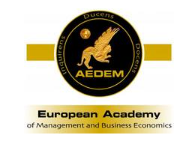Webinar: una herramienta actual global al servicio del deep-learning presencial
DOI:
https://doi.org/10.35564/jmbe.2019.0018Keywords:
webinar, traditional presentation, synchronic communication, asynchronic communication, high university educationAbstract
In this contribution, we give empirical evidence on our experience on the usage of webinars as a tool to complement teaching in the classroom in the framework of high university level education in economics and business. We design an ad-hoc survey to know the percentage of students who, before the experience, are familiar to the tool before the experience as well as the preferences of the students after the experience between “traditional presentations” and “webinars” We have also students’ feedback on the acquisition of competences. Being the experience implemented in different groups and using two alternative apps, we contrast whether the results are contingent of the group-subject and/or the tool. Results show an increase in the percentage of students that would choose using webinar instead of traditional presentations after the experience. Students admit showing lower levels of stage fright, being better trained to use other new technologies in the future and, feeling better trained for their future professional career. Moreover, recognise that webinar could give some dynamism to the teaching process in the classroom. Results are not contingent of the subject either the digital tool used to arrange the webinar.
Downloads
References
Bates, Mary Ellen; Chiba, Cathy; & Ojala, Marydee (2015): “Secrets of Successful Webinars”. Online Searcher, 39 (5), 10-15.
Bloom, B.S. (Ed.). Engelhart, M.D., Furst, E.J., Hill, W.H., Krathwohl, D.R. (1956). Taxonomy of Educational Objectives, Handbook I: The Cognitive Domain. New York: David McKay Co Inc.
Johnson, G. M. (2006). Synchronous and asynchronous text-based CMC in educational contexts: A review of recent research. TechTrends, 50(4), 46-53.
https://doi.org/10.1007/s11528-006-0046-9
Mayorga, E. P., Bekerman, J. G., & Palis, A. G. (2014). Webinar software: a tool for developing more effective lectures (online or in-person). Middle East African journal of ophthalmology, 21(2), 123.
https://doi.org/10.4103/0974-9233.129756
Meyer, K. A. (2003). Face-to-face versus threaded discussions: The role of time and higher-order thinking. Journal of Asynchronous Learning Networks, vol. 7(3), 55-65.
https://doi.org/10.24059/olj.v7i3.1845
Nagy, J.T. & Bernschütz (2016): “The impact of webinar-webcast system on learning performance”. Education and Information Technologies; November 2016, 21(6), 1837–1845
https://doi.org/10.1007/s10639-015-9422-4
Ng, K. C. (2007). Replacing face-to-face tutorials by synchronous online technologies: Challenges and pedagogical implications. International Review of Research in Open and Distance Learning, 8(1).
https://doi.org/10.19173/irrodl.v8i1.335
Power, Michael; & St-Jacques, Annie (2014): “The Graduate Virtual Classroom Webinar: A Collaborative and Constructivist Online Teaching Strategy”. Journal of Online Learning and Teaching. 10 (4).
Stodel, Emma J., Terrie Lynn Thompson; & Colla J. MacDonald (2006): “Learners' Perspectives on what is Missing from Online Learning: Interpretations through the Community of Inquiry Framework”. The International Review of Research in Open and Distributed Learning, 7(3)
https://doi.org/10.19173/irrodl.v7i3.325
Wang, Shiang-Kwei; & Hui-Yin Hsu (2008) Use of the Webinar Tool (Elluminate) to Support Training: The Effects of Webinar-Learning Implementation from Student-Trainers’ Perspective”. Journal of Interactive Online Learning, 7 (3).
Wilson, M.; & Gerber, L. E. (2008). How generational theory can improve teaching: strategies for working with the millennials. Currents in teaching and learning, 1(1), 29-44.
Zoumenou, Virginie; Sigman-Grant, Madeleine; Coleman, Gayle; Malekian, Fatemeh; Zee, Julia M K; Fountain, Brent J; & Marsh, Akela (2015):Identifying Best Practices for an Interactive Webinar. Journal of Family and Consumer Sciences. 107 (2), 62-69.
Downloads
Published
How to Cite
Issue
Section
License
Copyright (c) 2023 Journal of Management and Business Education

This work is licensed under a Creative Commons Attribution-NonCommercial-ShareAlike 4.0 International License.
License terms at: https://creativecommons.org/licenses/by-nc/4.0/legalcode




